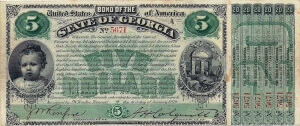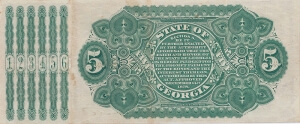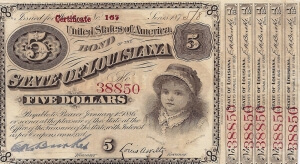Exhibit featuring Reconstruction-era bonds wins
Howland Wood Memorial Award
Editor’s note: See below for the full list of exhibitors, as well as examples from the Best-in-Show exhibit.
American Numismatic Association member Mack Martin won the Howland
Wood Memorial Award for Best-in-Show in numismatic exhibiting at the 2014
Chicago World’s Fair of MoneySM in Rosemont, Illinois. Martin’s
exhibit, “Baby Bonds,” featured notes issued in Georgia and Louisiana after the
Civil War that were used to fund Reconstruction efforts.
Martin, who previously won best-in-show awards at Central States
and Memphis Paper Money Show, said he began collecting Baby Bonds in 1975 .“That
started me collecting everything I have ever had a chance to buy,” he said.
For Martin, the fun of collecting Baby Bonds is researching the
history behind them through archived records. Only two states in the South, Georgia and Louisiana, issued
Baby Bonds. In Martin’s home state of Georgia, the use of Baby Bonds was
short-lived before the Federal Government shut the program down. Georgia Baby
Bonds were likely issued for less than a year, and those that were redeemed
were destroyed, which makes Georgia bonds exceedingly rare, Martin said.
The Radford Stearns Memorial Award for Excellence in Exhibiting
was presented to Thomas J. Uram as first runner-up for “The Historically
Significant Two Cent Piece 1864-1872” and Charmy Harker as second runner-up for
“Penny Potpourri — A Collection of Penny Creations.” Harker also won the Rodger
E. Hershey Memorial People’s Choice Award, which is selected by convention
attendees, and the Ira & Larry Goldberg Award for the best exhibit of
“Coins that Made History.”
The Thos. H. Law Award for best exhibit by a first-time exhibitor
went to Sunil Richardson for “Ancient South Indian Lead Coins and its
Uniqueness in World Numismatics.”
The Charles H. Wolfe Sr. Memorial Award for the Young Numismatist
Best-of-Show exhibit was presented to Garrett S. Ziss for “The Faces and
Stories Behind the Treasury Signers of U.S. Paper Money.”
Jeffrey J. Rosinia received the Derek Pobjoy Award for Best
Exhibit of Modern Circulating Commemorative Coins for “United States
Circulating Commemorative Coins.” He also received the Women in
Numismatics award for his exhibit “The Unappreciated Susan B. Anthony
Dollar: A Historic Coin that ‘Gets no Respect.'”
Gene Hynds received the Joseph E. Boling Award for Judging
Excellence.
Fifty-six competitive and seven non-competitive exhibits were
displayed at the World’s Fair of Money by 38 competitive and six
non-competitive exhibitors.
The American Numismatic Association is a congressionally chartered
nonprofit educational organization dedicated to encouraging people to study and
collect money and related items. The ANA helps its 25,500 members and the
public discover and explore the world of money through its vast array of
education and outreach programs, as well as its museum, library, publications,
conventions and seminars. For more information, call 719-632-2646 or go to www.money.org.
CONTACT: Jake Sherlock
Telephone: 719-482-9872
E-mail: pr@money.org
Below is a brief sampling of the Baby Bonds in Mack Martin’s winning exhibit. Text and photos provided by Mack Martin.

Georgia Baby Bonds
Informally known as Baby Bonds these certificates were authorized by the Act of December 14, 1878. These six year 4% bonds had a redemption date of January 1, 1885 and paid interest via six 4% interest coupons which were clipped from the bond annually during its life. The coupons are worth 20 cents and payable yearly by the state treasury office in the cities of Albany, Americus, Athens, Augusta, Columbus, La Grange, Macon, Savannah, and Rome. Signed by the treasurer John W. Renfroe and the Governor Alfred H. Colquitt. This $5 bond dated January 1st, 1879 has an imprint American Bank Note Company of New York. The image of baby Renfroe Jackson is at the left and the state coat of arms is at right, adjacent to the series of 6 coupons. These bonds also have a fancy ornate green back as illustrated.

$50 Georgia Baby Bond
The $10, $20 and $50 are specimens that were to be printed but never were as the US government intervened.The metal plate was used in Grover Criswell’s Currency Series Volume II book. It was luck that this piece was recovered.The treasurer, J. W. Reinforce, went to trial for impeachment for taking money and was found not guilty. He served out the rest of his term as treasurer.Georgia continued to redeem their bonds on into the 1900s.

Louisiana Baby Bond
Right after the Civil War in order to avoid US currency
taxes, Louisiana came out with the “Baby Bond.” Although it was a
bond it was used as currency.
A nice vignette of baby in bonnet, these bonds were
affectionately called “baby bonds” because of the baby on each bond
plus the small denomination of $5 which allowed many individuals to purchase
them and help the state of Louisiana during the period of reconstruction after
the Civil War.

Louisiana Baby Bond
A stamped signature of Louis A. Weltz, the Governor of
Louisiana who was elected in 1880 but died of tuberculosis just one year later
at the age of 38. E.A Burke, Democrat and ‘carpetbagger’, treasurer of
Louisiana, whose stamped signature also appears at the bottom of the bond,
stole over $1,500,000 from Louisiana over his ten years in office. After he was
indicted for embezzlement of state bonds he lived as a fugitive from justice in
Europe and Honduras until his death in 1928 at the age of 88.
In the late 19th century, numerous bonds issued in the 1860s
and 1870s by Louisiana were surrendered to the state in 1880 to be cancelled in
exchange for newly issued bonds. Burke issued the new bonds but never cancelled
the old bonds, instead reselling them in the open market and pocketing the
money for himself.
On August 2, 1884 the state of Louisiana failed to pay
interest on the ‘baby bonds”. About $18000 principal and
interest of these bonds is payable out of the collection of back taxes, and
there is no money to the credit of this fund now in the hands of the fiscal
agent.
2014 ANA
EXHIBIT AWARDS
Howland
Wood Memorial Award for Best-in-Show:
Mack Martin, “Baby Bonds.”
Radford
Stearns Memorial Award for Excellence in Exhibiting, presented to the first and second runners-up: Thomas J. Uram for
“The Historically Significant Two Cent Piece 1864-1872” and Charmy
Harker for “Penny Potpourri — A Collection of Penny Creations.”
Thos. H.
Law Award, for the best exhibit by a
first-time exhibitor: Sunil Richardson for “Ancient South Indian Lead
Coins and its Uniqueness in World Numismatics.”
Charles H.
Wolfe Sr. Memorial Award for the YN
Best-of-Show exhibit: Garrett S. Ziss for “The Faces and Stories Behind
the Treasury Signers of U.S. Paper Money.”
Rodger E.
Hershey Memorial People’s Choice Award,
selected by convention attendees: Charmy Harker for “Penny
Potpourri.”
Derek
Pobjoy Award for Best Exhibit of Modern
Circulating Commemorative Coins: Jeffrey
J. Rosinia for “United States Circulating Commemorative Coins.”
Women in
Numismatics Award: Jeffrey J. Rosinia for
“The Unappreciated Susan B. Anthony Dollar: A Historic Coin that ‘Gets no
Respect.'”
Ira &
Larry Goldberg Award, for the best exhibit of
“Coins that Made History”: Charmy Harker for “Penny Potpourri.”
Joseph E.
Boling Award, for Judging Excellence:
Gene Hynds.
Class 1:
United States Coins, Lelan G. Rogers Memorial. All United States coins and patterns and all coinage or trade tokens
used in pre-Federal America, except gold.
First place: Thomas J. Uram, for “The Historically
Significant Two Cent Piece 1864-1872.”
Second place: Andrew Blinkiewicz, for “The Last Decade of
Walking Liberty Half Dollars.”
Third place: Jeffrey J. Rosinia, for “The Unappreciated Susan
B. Anthony Dollar: A Historic Coin that ‘Gets no Respect.'”
Class 2:
United States Fiscal Paper, Sidney W. Smith/William Donlon Memorial. All paper money and bonds issued by the United States government,
including military currency; pre-U.S. colonial, Continental, and Confederate
paper money and bonds; state and private banknotes and bonds; scrip; college
currency; and stock certificates. Essays, proofs, and souvenir cards of such
items may also be shown.
First place: Mack Martin, for “Baby Bonds.”
Second place: Garrett S. Ziss, for “The Faces and Stories
Behind the Treasury Signers of U.S. Paper Money.”
Third place: Paul R. Hybert, for “What’s in Your Wallet,
Uncle Sam?”
Class 3:
Medals, Orders, Decorations and Badges, Burton Saxton/George Bauer Memorial. Medallic items not used as a medium of exchange, or not having
trade value. Orders and decorations, convention badges, and badges issued by
fraternal orders or other organizations. Excluded are Masonic pennies and
tokens included in classes 5-8.
First place: Darrell E. Luedtke, for “A Complete Collection
of Wooden Medals of the 1876 U.S. Centennial.”
Second place: Donald H. Dool, for “A Potpourri of
Medals.”
Third place: Andrew Blinkiewicz, for “Indian Tribal Series Medallions.”
Class 4:
Modern U.S. Coins and Modern Medals, John R. Eshbach Memorial. Coins issued 1960 and later, and medallic (non-denominated)
material issued by a private mint of any country after 1960, including
philatelic numismatic covers.
First place: Thomas J. Uram, for “Under the Dome.”
Second place: Jeffrey J. Rosinia, for “50 Years of Kennedy
Half Dollars.”
Third place: Scott A. McGowan, for “Monumental Coins.”
Class 5:
Tokens, B.P. Wright Memorial.
Items, including encased postage, issued unofficially as a medium of exchange
for goods and services or for advertising purposes, but excluding American
colonial items included in class 1. Includes Masonic pennies and substances
used in lieu of metal.
First place: Darrell E. Luedtke, for “The Origins of the
First Wooden Money of the United States.”
Second place: Robert Rhue, for “Pedley Ryan Dollars of 1933 –
Denver, Colorado.”
Third place: no exhibit
Class 6:
Casino Chips and Gaming Tokens, Archie A. Black Award. Items of all types and materials used as gaming pieces,
including traditional and non-traditional tokens and other money substitutes,
and including tokens used in military clubs.
First place: no award.
Second place: Brenda M. Black, for “Gaming Tokens of the
World’s Great Casinos.”
Third place: no exhibit
Class 7:
Engraved Coins, Love Token Society Award.
Numismatic items that have been converted into jewelry, amulets, or decorative
objects. Examples are love tokens, hobo nickels, and “pop-out” coins.
First place: Charmy Harker, for “Penny Potpourri: a
collection of penny creations.”
Second place: Judy Schwan, for “An Introduction to Love
Tokens.”
Third place: no exhibit
Class 8:
Elongated Coins, Dottie Dow Memorial.
Souvenirs created using an elongating machine, whether the underlying piece is
a coin, token, medal, or blank planchet.
First place: Cindy Calhoun, for “53 Years of JFK Elongated
Coins.”
Second place: Robert Fritsch, for “Elongating in Franconia
Notch.”
Third place: Mack Martin, for “The Elongated Coin Man — Ray
Dillard.”
Class 9:
Coins Issued Prior to 1500 A.D., Dr. Charles W. Crowe Memorial. Coins, including gold, issued by any government before 1500 A.D.
First place: Sunil Richardson, for “Ancient South Indian Lead
Coins and its Uniqueness in World Numismatics.”
Second place: Bruce D. Bartelt, for “From Croesus to Caesar:
Coinage from the First Millennium B.C.”
Third place: Kathryn S. Freeland, for “Traveling with
Hadrian: A Numismatic Journey.”
Class 10:
Regional U.S. Numismatics, William C. Henderson/Fred Cihon Memorial. Numismatic material of any type specific to a particular region
of the United States, such as the locale where the exhibit is being presented.
First place: William A. Burd, for “Medals Issued in Gold by
the Chicago Coin Club.”
Second place: Dennis Schafluetzel, for “City of Chattanooga
Notes: Authorized and Fantasy.”
Third place: Darrell E. Luedtke, for “Wooden Money from the
Great State of Illinois.”
Class 11:
Numismatics of the Americas, Henry Christensen/John Jay Pittman Sr. Memorial. Numismatic material of any type issued or used in the Western
Hemisphere outside the United States.
First place: Donald H. Dool, for “Nineteenth Century Latin
American Scripophily.”
Second place: W. Thomas Corey, for “Silver Cobs of the Major
Spanish American Mints.”
Third place: Dan Freeland, for “Selected Canadian Victory
Loan Bonds.”
Class 12:
Numismatics of Europe, John S. Davenport Memorial. Numismatic material of any type issued or used in Europe,
including Russia east to the Urals.
First place: Donald H. Dool, for “AD Dated Copper Coins of
the Fifteenth Century.”
Second place: Robert Fritsch, for “Four Award Medals by
Antoine Bovy.”
Third place: Thomas J. Uram, for “The Kings and Queens of
England Through Maundy Money.”
Class 13:
Numismatics of Africa and the Middle East, Menachem Chaim and Simcha Tova Mizel
Memorial. Numismatic material of any
type issued or used on the continent of Africa and in the Middle East (from
Turkey east through Iran and south to Aden).
First place: William Myers, for “An Unforeseen Problem with
the Ethiopian Coins of 1944.”
Second place: Simcha Laib Kuritzky, for “Henrietta Szold and
Her Legacy: Hadassah and Youth Aliyah.”
Third place: no exhibit
Class 14:
Numismatics of Asia and the Pacific, William B. Warden Jr. Memorial. All numismatic material issued or used in Asia east of the Urals
and Iran, and in the southeast Asian, Australasian, and Pacific islands
(excluding Hawaii under the U.S.).
First place: Fred Schwan, for “World War II Trench Art –
Southwest Pacific Area.”
Second place: no exhibit
Third place: no exhibit
Class 15:
Gold Coins, Gaston DiBello/Melvin and Leona Kohl Memorial. Gold coins of any provenance and era.
First place: Richard Feely, for “First Thirty Years of
Vatican Gold.”
Second place: no exhibit
Third place: no exhibit
Class 16:
Numismatic Errors and Error Varieties, Numismatic Error Collectors Award. Any numismatic material mis-struck or misprinted by the
producer, including varieties caused by die or plate deterioration or damage.
Items mutilated or altered after production are excluded.
No exhibits this year.
Class 17:
Numismatic Literature, Aaron Feldman Memorial. Printed and manuscript (published or unpublished) literature
dealing with any numismatic subject.
No exhibits this year.
Class 18:
General, Specialized, and Topical, Robert Hendershott Memorial. Numismatic material not covered in other classes or covered by
more than one class. Includes wooden money, political buttons and insignia, and
other exonumia, as well as media of exchange used in carrying out purchases and
business transactions by primitive people and later by others as they
progressed from barter to coins, or other items generally accepted as primitive
or odd and curious currencies. Also includes exhibits showing material linked
by design, such as elephants or bridges, or by theme, such as a world’s
fair.
First place: Darrell E. Luedtke, for “The Wonderful World of
Wooden Money.”
Second place: Tyler Rusnak, for “Stories From the Ground:
Tales of the Lost, the Circulated, and the Cherrypicked.”
Third place: Scott A. McGowan, for “Silver Coin to Coin
Silver.”
Class 19:
Convention Theme, Clifford Mishler Award.
Numismatic items of any type that, together with the exhibit text, illustrate
the announced theme for the convention at which the exhibit is shown. The 2014
convention theme was: Countries & Currency.
First place: William Myers, for “World War II Foreign Coins
From the United States Mint Composed of Shell Casing Metal.”
Second place: Simcha Laib Kuritzky, for “Israel &
Currency: Her Innovative Approach to the Question of Idolatrous Money.”
Third place: Donald H. Dool, for “Copper Coins of
Conflict.”
Class 20:
U.S. Commemorative Coinage, Society for U.S. Commemorative Coins Award. Material of any type or period related to United States
commemorative coinage and to the events being commemorated.
First place: Jeffrey J. Rosinia, for “United States
Circulating Commemorative
Coins.”
Second place: no exhibit
Third place: no exhibit
Class 21:
Emeritus, Barry Stuppler Award.
Exhibits by individuals not otherwise eligible to exhibit competitively, or
exhibits that have won best-of-show or twice won in class competition at the
World’s Fair of Money. Any other exhibit may also be entered at the exhibitor’s
option. The winner of this class does not advance to best-of-show judging.
First place: Brett Irick, for “Canadian Coins of
1947-1948.”
Second place: Ralph W. Ross, for “John F. Kennedy.”
Third place: no exhibit
2014 ANA YN
EXHIBIT AWARDS
Class Y1: United
States Coins, Edgerton-Lenker Memorial.
All United States coins and patterns and all coinage or trade tokens used in
pre-Federal America.
First place: Andrew Blinkiewicz, for “The Last Decade of
Walking Liberty Half Dollars.”
Second place: no exhibit
Third place: no exhibit
Class Y2:
World Coins, James L. Betton Memorial.
Coins issued 1500 A.D. or later in any foreign country.
No exhibits this year.
Class Y3:
Paper Money, Kagin Family Award.
Paper money and paper numismatica of all types, issued in any country.
First place: Garrett S. Ziss, for “The Faces and Stories
Behind the Treasury Signers of U.S. Paper Money.”
Second place: no exhibit
Third place: no exhibit
Class Y4:
Israeli or Judaic, J.J. Van Grover Memorial. Israeli or Judaic numismatic material of all types. In the event
no exhibits qualify, the award may be presented to another deserving exhibit.
First Place: Gavin Burseth, “Celebrating A Century of Honor –
Boy Scout Medallions and Coins.”
Second Place: no exhibit
Third Place: no exhibit
Class Y5:
Medals and Tokens, Charles “Cheech” Litman Memorial. Medals and tokens of all countries. In the event no exhibits
qualify, the award may be presented to another deserving exhibit.
First place: Andrew Blinkiewicz, for “Indian Tribal Series Medallions.”
Second Place: no exhibit
Third Place: no exhibit
Class Y6:
Medieval and Ancient, Charles H. Wolfe Sr. Memorial. All numismatic material issued prior to 1500 A.D.
No exhibits this year.
Class Y7:
Errors and Varieties, Alan Herbert Memorial. Any numismatic material mis-struck or misprinted by the
producer, including varieties caused by die or plate deterioration or damage.
Items mutilated or altered after production are excluded. In the event no
exhibits qualify, the award may be presented to another deserving exhibit.
First Place: Tyler Rusnak, for “Stories From the Ground:
Tales of the Lost, the Circulated, and the Cherrypicked.”
Second Place: no exhibit
Third Place: no exhibit